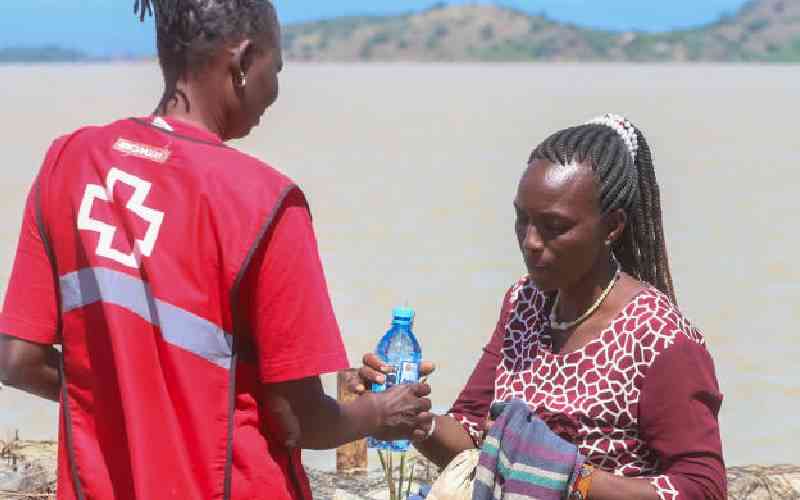Every two hours in Kenya, every single day, a woman dies during pregnancy or child birth.
To put that in perspective, between the time you have breakfast at 7 am and 10 o’clock tea, two women will have died due to pregnancy-related complications.
According to the National Alliance Secretary of Health, an estimated 5,000 women in Kenya die annually during pregnancy or delivery. Other statistics indicate a higher number of up to 8000 deaths annually.
That is equivalent to an 18-seater bus full of pregnant women crashing daily, and killing all the passengers, according to Kenya’s First Lady, Her Excellency Margaret Kenyatta, who is championing a Beyond Zero Campaign to mitigate against maternal deaths.
That this is happening in 2015, when we should have met out Millennium Development Goals on maternal mortality rates, is a tragedy.
There is no gainsaying that the issue of maternal deaths is a major challenge and has been identified as one of the MDGs, together with neo-natal health, that is least likely to be met by the end of the year.
Kenya is not only lagging behind in maternal health care but it has experienced an increase in maternal mortality.
In 2012, the Kenya Demographic Health Survey indicated that maternal mortality in Kenya stands at 488 deaths for every 100,000 live births in eight regions.
Although the maternal mortality ratio fell from 590 in 1998 to 414 in 2003, it rose to 488 in 2009, according to According to the MDG Acceleration Framework and Action Plan 2014.
HIGH BURDEN AREAS
Kenya’s target of reducing maternal mortality rate (MMR) from 410 to 147 per 100,000 live births by 2015 was not met, and instead it increased to 488.
According to a report by United Nations Population Fund, 15 counties with the highest number of maternal deaths and highest maternal mortality ratio contribute over 60 per cent of the national total.
The counties are Mandera, Turkana, Wajir, Nairobi, Migori, Nakuru, Siaya, Kisumu, Homa Bay, Kakamega, Marsabit, Lamu, Garissa, Taita Taveta and Isiolo. It might come as s surprise that Nairobi is listed among top five counties with the highest burden.
John Nduba, the Health Programme Director at Amref, says this is caused by the number of referral cases brought to Nairobi in critical condition, often when it is too late.
Other issues influencing the high rates in Nairobi, especially in informal settlements, include unsafe illegal abortions and use of traditional birth attendants who do not refer the cases to hospitals in time.
Stay informed. Subscribe to our newsletter
The role played by the mother in the family is crucial for child survival and the proper upbringing of the newborn and the entire family. The effects of the death of a mother in a family are devastating.
A report titled A Price Too High to Bear by Family Care International shows that families experiencing a maternal death spend more on medical care and funeral expenses than all other yearly expenses — food, shelter and education — combined.
Some families have had to sell household property or borrow money to pay for their upkeep.
“Funeral expenses of Sh 150,000 to Sh 200,000 causes the family to sink deeper in poverty which could otherwise be prevented through the simple action of taking the mother to a health facility,” says UNFPA representative Siddharth Chatterjee.
“The father is left to care for the children on his own, and he also has to look after the farm. He might have to hire help, and that impoverishes the family further.”
Morris Buliva is a living testimony to such a scenario. He lost his wife of 11 years during delivery of their third child, a daughter, in what was termed as a case of amniotic fluid embolism.
This is a rare, but serious condition that occurs when amniotic fluid enters the maternal bloodstream.
In his wife’s case, the bleeding after delivery would not stop.
“My life changed. I was left to care for a newborn baby and our two sons aged seven and ten,” Morris says.
“Without a mother’s touch, our home was dark and cold and the children and I were lost and confused.
“As the baby grew, she kept asking the house help and any other woman who visited if she were the mother. I realised that a man can have all the money and ideas but without a mother to his children, it becomes difficult to implement anything. Mothers are pillars that hold everything together and make the home solid.”
The Cabinet Secretary for Health, James Wainaina Macharia says “maternal deaths have devastating effects on family members.”
While most neonatal babies die when the mother dies, the loss of a mother’s income and care creates a chain of disruption, and causes emotional pain, economic loss, diminished educational and life opportunities for the remaining children. This deepens and perpetuates a cycle of poverty.
GOVERNMENT INTERVENTIONS
Macharia says that within six months of the introduction of free maternal healthcare in June 2013, the number of mothers visiting hospitals increased from 44 to 66 per cent.
In that duration, maternal mortality rates dropped by eight per cent and child mortality rates dropped by 15.3 per cent, saving the lives of 600 mothers and 16,000 babies.
Wavering the Sh20 requirement at health centres increased the number of mothers visiting health centres from 12 million to 18 million.
To accelerate the attainment of Millennium Development Goal 5 which pertains to maternal mortality, UNFPA organised a Governors Consultative Conference in 2014, to sensitise the county bosses on the need to prioritise maternal health issues in their areas. According to Mr Chatterjee, Kenya is listed among the top 10 countries globally with the highest maternal mortality rates.
“Though Kenya has been a flag-bearer of human development in Africa, very little will be achieved unless mothers are cared for well.
“When political leadership at a national and county level is mobilised and women are valued as contributors of economic future, then maternal deaths can be reduced to 176 per 100,000 live births. Yet even then that is still one death too many.”
The 15 counties with the highest burden of maternal deaths pledged their commitment to prioritise basic healthcare for mothers.
The governors promised to intensify efforts to improve maternal healthcare by increasing budget allocation towards quality maternity and newborn health services and also improve infrastructure like roads to make it easier for mothers to access health care services, train health workers and provide safe water and food.
It should not be lost on Kenyans that most of the deaths are preventable if a high number of pregnant women are taken care of by skilled health workers.
CAUSES OF DEATHS
Maternal deaths occur due to direct and indirect causes.
Direct causes of maternal death include haemorrhage (41 per cent) infection (21 per cent), eclampsia (15 per cent), abortion (6 per cent), obstructed labour (3 per cent) and others threats account for 14 per cent.
Indirect causes of maternal death are HIV and Aids which accounts for 40 per cent, anaemia 28 per cent, cardiovascular 18 per cent and malaria 6 per cent.
Other threats that include FGM, early marriage and a concoction of traditional, cultural and religious practices that prevent women from seeking services of skilled midwives in health centres cause eight per cent of the deaths.
When a mother is on anti-retroviral therapy, the chances of mother-to-child-transmission are reduced from 30 to 3 per cent.
High blood pressure and pre-eclampsia can be managed through early deliveries or a cesarean section.
There are also some issues and challenges which include inadequate health centres with maternity facilities; shortage of medical supplies and an overstretched health workforce; low doctor-to-population and nurse-to-population ratios and negative attitude of health workers.
SOLUTIONS ARE AVAILABLE
Suggested ways of reducing maternal mortality rates include an increase in the number of pregnant women attending ante and post-natal clinics, especially for subsequent births.
Women at the grassroots should be educated on the benefits of acquiring the services of skilled healthcare providers during pregnancy and after child birth.
They should also be encouraged to move closer to maternity facilities that have emergency services, doctors and midwives before their due date.
Above all, they should be educated on personal post-natal care, birth spacing and informed about the danger signs to look out for in order to reduce the number deaths resulting from post-partum haemorrhage.
While the need to enhance midwives’ obstetric clinical skill with modern emergency delivery methods cannot be over-emphasised, there is also a need for midwives to offer exemplary, positive, respectful and compassionate patient care irrespective of clinical setting.
But at the same time, their (midwives’) working conditions should be improved.
Their numbers should be increased to improve midwife-to-patient ratio in district hospitals, and they should be eligible for various compensation schemes and motivational awards.
In September 2013, an incident of a woman giving birth on a cold dirty floor at Bungoma District Hospital was captured on camera.
The nurses did not assist her and instead were hurled abuses at her for messing up the floor.
In another incident, a mother accused personnel at a Nyeri hospital of negligence when she delivered while standing. The baby fell on the floor and died within ten minutes.
The medical superintendent attributed the incident to a shortage of staff.
Early this year, a mother bled to death at Nairobi’s Mama Lucy Hospital after delivering a baby girl.
These unfortunate instances are a testimony that women seeking maternity care receive varying degrees of ill treatment ranging from relatively subtle disrespect of their autonomy and dignity to outright abuse which can be physical assault, verbal insults, discrimination, abandonment, or detention in facilities for failure to pay.
A woman never forgets if she is mistreated during pregnancy or delivery and evidence is now emerging that this fear of being treated badly and insulted in health facilities is holding them back from seeking help.
 The Standard Group Plc is a
multi-media organization with investments in media platforms spanning newspaper
print operations, television, radio broadcasting, digital and online services. The
Standard Group is recognized as a leading multi-media house in Kenya with a key
influence in matters of national and international interest.
The Standard Group Plc is a
multi-media organization with investments in media platforms spanning newspaper
print operations, television, radio broadcasting, digital and online services. The
Standard Group is recognized as a leading multi-media house in Kenya with a key
influence in matters of national and international interest.
 The Standard Group Plc is a
multi-media organization with investments in media platforms spanning newspaper
print operations, television, radio broadcasting, digital and online services. The
Standard Group is recognized as a leading multi-media house in Kenya with a key
influence in matters of national and international interest.
The Standard Group Plc is a
multi-media organization with investments in media platforms spanning newspaper
print operations, television, radio broadcasting, digital and online services. The
Standard Group is recognized as a leading multi-media house in Kenya with a key
influence in matters of national and international interest.








